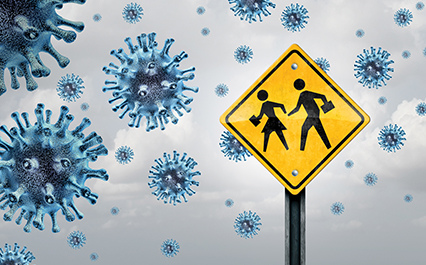Page Content

ATA president Jason Schilling is urging school authorities to start spending the federal money they’ve been given to address COVID issues in schools.
Authorities need to make decisions and spend money to address re-entry problems, says ATA president
It’s time for school boards and superintendents to start spending the federal money they’ve been given and address issues that are affecting the safety and well-being of teachers and students.
That’s the view of Alberta Teachers’ Association president Jason Schilling as the new school year settles in and the number of COVID-19 cases continues to rise.
“Teachers and principals are concerned right now,” Schilling said. “They’re feeling a lot of stress and anxiety with the re-entry plan. There’s a lot more that has been added to their plates.”
Teachers in some areas are reporting that they are being required to do much more cleaning than was expected, giving them little or no time to transition between classes or take a proper lunch break.
Many teachers are also being required to take on additional students in their classes as teaching colleagues are being moved to online delivery.
“We need to ensure that school boards are hiring extra staff,” Schilling said.
Schilling is participating in regular meetings of education stakeholders, facilitated by the government. He said he uses these meetings to express the concerns that he’s hearing from teachers, such as the need to reduce class sizes and increase the capacity for physical distancing.
“We still have teachers out there who don’t have their teaching assignments yet,” Schilling said, “so we’re really trying to hold the feet to the fire of those who are in charge of this plan.”
Over the summer, call volumes to the ATA were nearly 50 per cent higher than the usual volume, as teachers had questions and concerns related to school re-entry, collective agreements, contracts etc.
Federal funding of $250 million, announced in August, has been provided to school boards on a per-capita basis to address pandemic-related issues, but so far there is little evidence of the money being spent and improvements happening, Schilling said, adding that the onus is on school boards to take action.
“They actually need to start making those decisions and addressing the needs in the building,” he said.
He said that teachers want to be at work with their students, but they want conditions to be safe.
“That’s something that they’re not seeing, and they feel like they’re not being listened to.”
Outbreaks and individual cases
As of Sept. 10, outbreaks of COVID-19 (defined as two or more cases) had been reported at two Calgary schools — St. Wilfred Elementary and Henry Wise Wood High School — as well as Chinook High School in Lethbridge. The previous day, Alberta Health Services confirmed that 16 individuals with COVID-19 were present at 16 schools while infectious. The identified cases did not obtain the infection within the schools.
“It seems the majority of our new cases are coming from close contact, household transmission, social gatherings or other type of events that aren’t necessarily easily controlled by formal public health restrictions or measures,” said chief medical officer of health Dr. Deena Hinshaw.
Societywide, the number of COVID cases in Alberta has increased to levels last seen in May. On Sept. 9, Premier Jason Kenney said he doesn’t intend to impose more restrictions on society, as doing so would come at the expense of people’s livelihoods.
“We’re not going to micromanage our way out of this. We’re only going to get through this if people exercise personal responsibility and that’s what we call on Albertans to do.” ❚
In their own words
Teachers share their thoughts on school re-entry
-
Finding out that Ontario teachers are being provided two medical masks a day and kindergarten teachers are being given medical gowns doesn’t make me feel very enthusiastic about our two cloth masks for the year. Usually I find joy in back to school; not this year.
- I am finding it tough. Love seeing the kids, but it is not fun sitting in rows and nagging about masks, hand sanitizer and distance non-stop. Sad to not be able to do group work and work the way I usually do.
-
It’s very, very overwhelming. In a school full of people, you feel very alone. Questions are left unanswered and protocols are all wishy-washy. But the bright side is the eager, smiling children that walk through that door every day. They are the only thing that keeps me going every day.
-
I’m excited to return to school and see the kids. They’re generally a great bunch and I am lucky to teach at the school I do. However, I am more than a little concerned with my class sizes (34, 34, 38, 29). I see 126 students come through my room (high school) and feel it is only a matter of time before transmission occurs. The kids have been OK about wearing masks and sanitizing their desks, but we’ve been able to go outside and give breaks. When their fatigue sets in surrounding the preventive measures — say mid-October — I expect cases to rise.
It’s exhausting managing this and worrying about the future.
- Too much time spent sanitizing desks, pumping cleaner in each kid’s hand as they enter and exit the room, but we still have the entire curriculum to cover.
- Now, after this week, we will be losing teachers, so our numbers will go from 23 to 29/30. This is not helpful to pack in the kids. Many have gotten behind without doing any work at home, and now let’s cram them in. Where is the money from the government going? I don’t see any on the front lines!!
|
